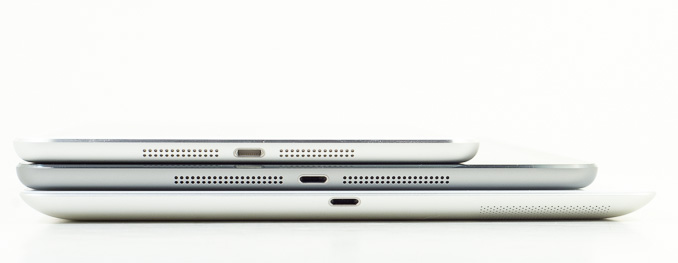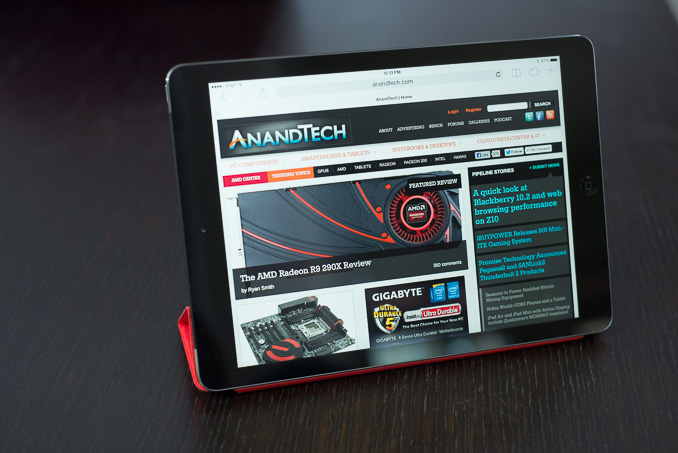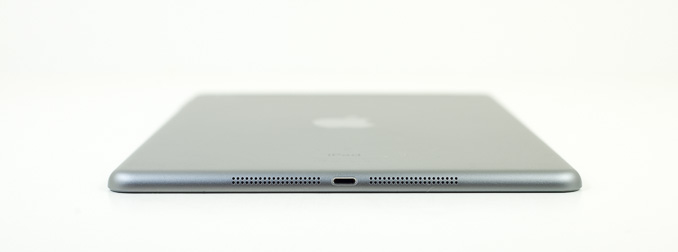The iPad Air Review
by Anand Lal Shimpi on October 29, 2013 9:00 PM ESTFinal Words
Two weeks ago I had all but written off the bigger iPad. It was too bulky and just no where near as portable as the iPad mini. Once the latter gets a Retina Display and equal hardware across the board, why would anyone consider the bigger model?
The iPad Air changed my perspective on all of that. It really does modernize the big iPad. While I suspect there are still going to be a lot of users who prefer the smaller form factor of the iPad mini with Retina Display, I do feel like there are those users who will continue to appreciate all of the benefits that go along with having a larger display. Text is easier to read, particularly on desktop versions of websites. Photos and videos are larger and thus more engaging as well. In the past there was this complex matrix of tradeoffs that you had to make between iPad and iPad mini. This generation, Apple does away with all of that.
All you need to do is pick your screen size. If you prefer the 9.7-inch form factor of the original iPad, the Air gets you as close as possible to a mini without giving up that display size.

From top to bottom: iPad mini, iPad Air, iPad 4
The name does the product justice in this case. In two hands or lightly propped up against something (palm, legs, chest), the iPad Air feels incredibly light - the weight just seems to disappear. The larger chassis doesn’t feel very dense at all. The in-hand feel of the device is really unlike any other iPad. It feels like a lightweight slate, rather than a heavy computing device. This is the iPad that Apple likely wanted to launch on day 1, it just took a bit over three years to get here.
Build and material quality are of course excellent. The iPad Air borrows much of the design language from the iPad mini, and makes the transition to a larger display quite nicely. The Air ends up looking a lot more modern than its predecessor.
Despite making the transition to a thinner touch and display stack, the iPad Air’s display is every bit as good as previous Retina Display iterations. Color accuracy remains best in class, delivering an out of box display experience that’s better than most systems, even at substantially higher price points. The only thing that the iPad Air leaves me wanting on the display front is a lower reflectance stack. Laminating the cover glass to the LCD panel is something that Apple does on both the iPhone and iMac, it’s time that the same feature is brought down to the iPad.
Apple’s decision to unify silicon across the iPhone 5s, iPad Air and iPad mini with Retina Display is an interesting one, but ultimately it doesn’t come with any real tradeoffs for iPad owners. Apple’s own 64-bit Cyclone cores are incredibly powerful, even more so than I originally expected when I reviewed the iPhone 5s. Apple seems to have built a bigger, higher performance CPU architecture than any other ARM player, including ARM itself. The design isn’t perfect, but it’s a completely different caliber performer than anything else it competes against. As such, Apple was completely justified in putting the A7 in both the iPhone 5s and the iPad Air. If anything, I’d argue that it might be overkill for the 5s given the device’s smaller battery, but my sensibilities soon get the best of me and remind me that more performance on tap is never a bad thing.
On the GPU front, Apple does increase performance over the iPad 4 as well - despite having a narrower memory bus. The increase in performance ranges from 40 - 70% depending on workload. I suspect we’re beginning to see some of the limits of 28nm here as Apple would’ve traditionally gone for an even larger GPU.
Despite having a smaller/thinner/lighter battery, battery life improves across the board compared to the 3rd and 4th generation iPads. Battery life in our web browsing, video playback and gaming workloads is better than either of the previous two iPads. Only the iPad 2,4 was able to deliver better battery life, but nothing with a Retina Display can match the iPad.
Cellular integration remains awesome on the iPad Air. With a single SKU covering 34 countries and no network operator lock, at least for those devices sold in the US, the LTE iPad Air is amazingly flexible from a network portability standpoint.
Improvements around the edges are nice as well. The inclusion of a second microphone can improve FaceTime HD calls in noisy environments, and faster WiFi is a nice addition.
My only complaints are limited to iOS 7, memory size and pricing. It’s clear that even on the fastest hardware Apple has to offer, iOS 7 isn’t always super smooth (particularly when using multitasking gestures to switch between apps) on an ultra high resolution device. The move to a 64-bit OS and applications makes a lot of sense, but with no corresponding increase in DRAM size Apple creates additional memory pressure on all of the A7 enabled devices. Finally, I’d love to see Apple update the default iPad configurations. Although 16GB is fine for a device that’s not going to be storing a ton of photos/videos locally, it would really be nice to get at least 32GB on the entry level iPad. The first complaint I suspect will be addressed over time. The second is a reality we just have to live with unfortunately, and the third won’t change until market dynamics force it to.
The iPad Air is the most significant upgrade to the 9.7-inch iPad in its history. It’s lighter, more portable, more usable and faster than any previous iPad. It doesn’t fundamentally change what you can do with a tablet, but if you’re in the market for one the iPad Air really is the best iPad to date. Competition is definitely more stiff among the smaller tablets thanks to the Nexus 7, but in the nearly 10-inch tablet space it seems like Apple is going to continue to enjoy a great position there.












444 Comments
View All Comments
tipoo - Tuesday, October 29, 2013 - link
Agreed, a sub-name only makes sense if a second product is coming out. 12" iPad Platform based system in a MBA form factor, mayhaps?User.Name - Tuesday, October 29, 2013 - link
This device, like so many recent Apple product announcements, is both very exciting, and very disappointing at the same time.Dropping 1/3 of the weight from the iPad and making the device smaller while keeping the same display size is a huge improvement over the old hardware.
But there are so many things I have wanted Apple to address, that they have not.
1. The display is not bonded to the glass. My television from 2010 has this, so does my notebook, my phone, and Microsoft manage it with the Surface. This needs to change.
2. Even though moving to 64-bit requires more memory, they stuck with 1GB of RAM. I was already constantly running into a lack of RAM on my iPad 3.
3. It still starts at 16GB. 16GB on my iPad 2 was tight, and it got worse once apps started coming with retina assets. With no external expansion, 16GB seems awfully tight now.
4. There's no A7X. Yes, the A7 may be a fast chip, and there are less thermal restrictions inside the iPad than the iPhone, but the demands of the iPad are significantly higher. I suppose with them making the device a lot smaller, this is the compromise they thought best, but it's still disappointing.
I sold my iPad six weeks ago in preparation of the new tablet devices, fully intending on replacing it with a Surface Pro 2, but after seeing that they just stuck with the old display rather than improving its color accuracy (all they did was load an ICC profile) and the disappointing battery life, I decided against it.
Being without the iPad for six weeks though, has made me reconsider whether I want one. It was originally my fallback plan if the Surface didn't work out, but now I'm unsure that I want another. The main reason I was moving away from it to begin with was due to the software restrictions, and annoyances such as the screen reflections and lack of RAM, which have not been addressed at all with this update.
I'm having a very difficult time trying to find something which meets my requirements.
dugbug - Wednesday, October 30, 2013 - link
"4. There's no A7X. Yes, the A7 may be a fast chip, and there are less thermal restrictions inside the iPad than the iPhone, but the demands of the iPad are significantly higher. I suppose with them making the device a lot smaller, this is the compromise they thought best, but it's still disappointing."Why? Why do you need an A7X and why is that disappointing?
User.Name - Wednesday, October 30, 2013 - link
In some of the tests, it seems to be performing worse than the iPad 4.In many of the tests, performance is lower than that of the iPhone 5s - by as much as 50% in some tests.
I expect better performance from a large tablet device than I do from something which fits in my pocket.
It means that if a developer does a "simple" port from one device to the other, the iPad version is going to perform worse than the same thing running on an iPhone. I think that's very disappointing, and it's the reason the A5X and A6X existed.
errorr - Wednesday, October 30, 2013 - link
I don't think there are any apps out there that can stress the A7. I see it more that Apple chose ro put a throttled tablet SOC into a phone. It has way too much power for the 5s screen and will bottleneck elsewhere first.dugbug - Thursday, October 31, 2013 - link
The A7 has a lot of headroom, way overkill for the phone. seriously, this is such an edge concern.Kvaern - Wednesday, October 30, 2013 - link
I don't quite get the fuss about the 16gb baseline.I mean if it isn't enough for you then get a larger model but why would you want to force 32gb on people who needs no more than 16gb?
User.Name - Wednesday, October 30, 2013 - link
Apple seem to operate largely by keeping their prices fixed, and introducing better hardware at the same price point. 16GB is not a lot of storage now, considering what Apple is charging, and when there is no option to expand that.As I said in my previous post, I originally purchased a 16GB iPad 2, without knowing how restrictive that would be - you get less than 16GB usable space, and what you may not realize is that you also have to keep 1-2GB free to be able to update apps. (or at least you did at the time; iOS 7 may have changed this?)
Once apps started adding retina assets, many of them increased 2-3x in size, further reducing the number of apps you could keep on the device, even though the iPad 2 itself had no use for those assets.
I think the base spec being 16GB really hurts the user experience. I constantly found myself having to remove apps from the device, and couldn't really store any media on the device itself. (even podcasts had to be restricted)
I then went with a 64GB iPad 3 the next year, and now I would probably recommend that most people buy the 32GB model. I know too many people that bought a 16GB iPad, only to find themselves replacing the device the next year, not because they wanted a faster device, but because it didn't have enough storage for all the apps they wanted to run. (games and educational apps seem to be the worst offenders)
I'm sure there are some people whose usage is fine with 16GB, but when Apple are charging a premium price, I just don't think 16GB is enough.
It's a similar situation to the RAM in the device. 64-bit now requires more memory than previous generations of the iPad, but they stuck with 1GB of RAM, making the user experience worse than it was before.
akdj - Wednesday, October 30, 2013 - link
"64-bit now requires more memory than previous generations of the iPad, but they stuck with 1GB of RAM, making the user experience worse than it was before."Hmmm....I read the whole article, didn't notice that mentioned at ALL! Seemingly, overall...Anand's experience with the 'Air' was significantly 'better' than ANY other tablet he's reviewed/used.
As far as NAND/Storage size....this is ubiquitous throughout the industry. Most OEMs are shipping 16GB models as their 'entry' level device. For folks not interested in downloading games or 'big' apps (My mom loves her iPad 2 16GB and has never run out of space)---that amount is just fine. No other tablets are shipping with 128GB currently, right? You've got choice. Use it. Use your head. Now that you know 16GB isn't enough for you....and 64 is too much, you've finally figured out you need 32GB. Good for you....as I'd also like to see Apple start off with a 32GB iOS device as the minimum, they're not aiming the 16GB model at power users...they offer 4 different sizes with your choice of WiFi or LTE. Same thing, gotta make that choice. I'd love every model to include LTE. It doesn't. You HAVE to make a choice that benefits YOU.
Everyone uses their tablets differently. With cloud storage (Dropbox, iCloud, Box, Google Drive, et al.), one has the option to store their information outside of the tablet and access it when necessary. Many folks don't game. You can now stream from iTunes Match...no need to d/l the entire movie first. That said...if you want more storage, BUY more storage! Apple is in parity with the rest of the entry level OEMs....16GB is pretty standard, other than some that are still releasing 8GB models (first Nex7?)....or models with only options of 16 or 32GB on board.
J
User.Name - Wednesday, October 30, 2013 - link
Yes, but other devices shipping with 16GB storage are significantly cheaper, and/or have expandable storage options. (plug in a 64GB SDXC Micro card)And to move from 64GB to 128GB (+64GB) costs $100 - the same as moving from 16GB to 32GB. (+16GB)
I'm quite sure they could offer a 32GB at the current price.
As for 1GB RAM affecting the user experience, I suppose it depends how you use the device.
I was constantly running out of RAM on my iPad 3, which also had 1GB - and that is effectively more than the Air has.